Often seen in the realms of films and video games is the one man tank crew, that couldn’t be further from how Challenger tanks really work.
This portrayal has led to the belief that you can spare a man from the Challenger 2, the Russians use auto-loaders in the T series tanks so this is the way forward right? Wrong! Every man is as much a vital part of the running of the tank as a part of the engine or gun itself.
The tank crews are a unique part of the British Army and they have a certain style, often coming across as ‘elitist’, eccentric or a walking pamphlet of statistics.
It’s true the Royal Armoured Corps has a different ethos, especially to the infantry, it is necessary to the way they operate, but I will dig into this more in depth in a future article. What I want to answer is how does a Tank WORK? I do not mean the mechanics (Perkins V12 4-Stroke engine simply) but how everyone has an important role and how they do it.
It is a four man crew, Driver, Gunner, Operator (Loader in layman terms) and commander. A classic career progression in the 3 Regular Regiments, King’s Royal Hussars, Queen’s Royal Hussars and Royal Tank Regiment moves through these in order, with a few exceptions, and in the Army Reserves, Royal Wessex Yeomanry, its possible to step into any of the first three.
Starting with my own role, a Challenger 2 driver. The job is to move the Tank from one point to another, because of this its necessary to be good at assessing the ground, even though in the lowest compartment, and maintenance of anything not found in the turret, in order to keep it moving, engine, tracks, wheels and drive parts are al the drivers responsibility, along with many others.
Almost all of the tasks involve two to three crewmen working together so the driver must be skilled as a team player too, to get the turret crew to help when needed, rather then going to bed. Whilst moving across open country it will often be the driver and commander who are the busiest talking to each other, looking at ground picking a route.
When tree lines and ridges are approached the gunner will talk the gunner onto the exact distance so he can see targets without exposing himself. The driver is in his own world, even though only feet away from his comrades, he doesn’t see the turret ring turning just behind his head, he is fixated on the periscope. The only way for visual communication when locked down, is to roll onto your stomach when the gun is over either side, then you are just below the side of the gun, by the Operators legs.
It is then possible to be passed down a meal or a drink. When in action, the driver will assist in searching for obvious targets to the front axis, as these can easily be lost with the gunner and commander using scopes rather then their mark I eyeball.
The gunner, as the name suggests fires the gun, still 120mm rifled, with little physical difference to the Chieftain. Using two primary sights, with a myriad of displays he can engage targets with a huge first hit first kill ratio, up to 99% for a competent crew. Due to the sight limitations however they cannot see wide arcs, relying on the commander to give them the likely arc of enemy targets, rather then scanning round and round, spinning the crew. Its an awkward cramped position, between the commanders legs, with a chest plate rammed into the sternum to hold him fast.
It is also possible, if not enough communication with the driver is going on for the gunner to be knocked unconscious by his own sights and instruments.
Operator, more commonly known as the loader, during an engagement will load the three part ammunition into the breach. It can be down to their technical skill or brute strength that the crew will be relying upon for survival. It can be one of the most physically demanding roles. After loading and firing several rounds in a short space of time the operator is often drenched in sweat.
The operator has many other roles to play in the working of the crew. He maintains and tunes the temperamental Bowman radio sets, cross country he helps spots routes or obstacles when the commander is busy, but the most important section, for a British Army crew is ‘admin’. Here a good operator is worth his weight in gold. He will have all the crews kits stowed on the back and inside the turret where it needs to be, he will be doing any small jobs that need doing whilst the driver is locked down and the gunner is in position, but the most important, is he has the BV. The BV or Boiling Vessel, is the life blood of the armoured crew, every tank designed since 1945 for the British Army has had one, it is essentially a square kettle, used for heating meals, getting warm water to wash in, and provide a constant supply of tea and coffee, without this morale plummets.
The operator can cheer the entire crew up by passing round hot meals and drinks when everyone is exhausted, and after several days working long days in cramped conditions the timely arrival of a thermos of tea passed down to the driver cannot be underestimated.
Finally the commander, without a shadow of a doubt the busiest man in the crew, and the make or break man, with him the reputation and effectiveness of the crew is measured. Either an experienced NCO commanding their first vehicle or a young officer, in charge of a troop of 4 tanks, including his own, every commander has multiple tasks to do.
First of all is coordination, with 3 other men all having to work together, often not being able to see each other, things can get heated or confused. Secondly, communication with others, both to his own troop, infantry or attached elements working close by and having to relay orders with the squadron leader, who is playing a bigger game of chess. The commander also has the best situational awareness, in the highest point of the vehicle, there is a ring of window slits below the hatch, his own gunnery sights and he can utilise the brilliant ‘hunter-killer’ mode, spotting and laying targets for the gunner to engage next, so as soon as one enemy target is found the next can be searched for, allowing for a constant stream of engagements rather then the gunner scanning, wasting valuable minutes. This means the vehicle can be moving forwards, with the gun over the side, with the commander looking through his remote sight in an entirely different direction, it is possible for the inexperienced to get very confused, tempers can fray, but that is the test of a crew.
A good example of how a brilliant crew can work, is a ‘tank surfing’ engagement. Here the enemy are over a ridge. The commander with step out on top of the turret with his binoculars. Using his headset he will talk the driver to creep up so that he can just see over, exposing nothing of the tank apart from his head an the aerials. If an enemy target is spotted all crew coordination works quickly, the commander will jump back in relaying its’ position and type.
From this the operator will load the appropriate round whilst the driver will reverse a short distance in case the commander was spotted, then will advance quickly from a different angle (known as jockeying) until the gunner has a clear vision, he will then break and select the likely gear needed, either reverse again or one of the forward if an advance is going to happen, the operator will slide his safety shield across, the commander will talk the gunner onto target, who will laser the distance, adjust and fire.
The commander will gauge whether it has been destroyed, in which case they will likely move quickly, or needs to be hit again, when the operator will work as quickly as possible to load another round into the breach, a process that will be repeated, hopefully as a well practised process, but none the less complex for all 4 crew are heavily involved and none is less important then another.


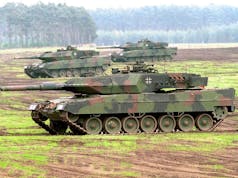
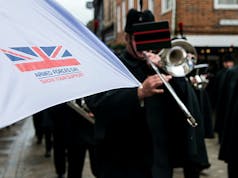
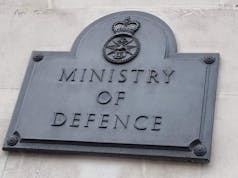

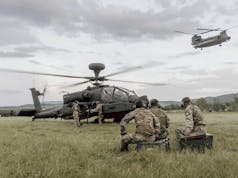

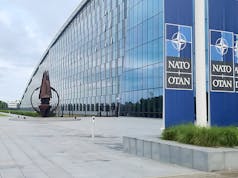
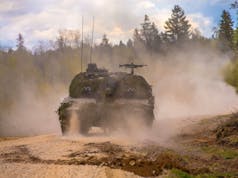

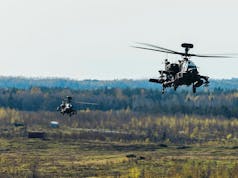

The commentary above raises an interesting question on how a tank is fought but also the doctrine that is developed from the tank’s design. For instance, it will be interesting to see how Russia will use their new T14 Armata MBTs. From its design I presume they will still use them in the classic Soviet method as part of a massive metal fist, using overpowering numbers to smash through an opposing force. This can be concluded by the amount of protection that is afforded by removing the crew from the turret and placing them in an armoured capsule in the hull.
The reason for this is that the Armata uses the main armament contained in a remote turret with an autoloader. With the Driver, Gunner and Commander sitting below and in front of the turret. The turret does contain their Electro Optic targeting systems which I presume allows them to operate in hunter killer mode.
I suspect that the crews ergonomics will be much improved over the previous generation T90 series of tanks, allowing better inter-crew communication. However, I think that actually fighting the tank may be not as efficient as a crew served turret. For instance the Commander will struggle to find targets if his combined EO sight/RWS is damaged or inoperable, as he is now placed in front and below the turret. Can’t really stick his head out the hatch with the turret spinning around! The tank is effectively blind to the rear if the Commanders sight doesn’t work (unless they have fitted extra cameras to cover this)! Surely the Commander’s sight would be one of the primary targets, especially for a sniper.
This may raise an interesting question of what would be the best tank design for fighting? As the tank must be able to carry out a number of roles be it frontal assault or holding the line. But most importantly it must still be able to operate with damaged systems. Protecting skilled crew is a priority but how is this balanced against fighting the vehicle?
The T14 Armata may be a generation ahead of the Chally, but is it a better fighting vehicle? I suspect that the doctrine for using the T14 will be as the main frontal assault vehicle backed up by a plethora of T90s.
Dave wrote:
“I suspect that the doctrine for using the T14 will be as the main frontal assault vehicle backed up by a plethora of T90s.”
Funny enough the exact same SOP during the early 50s and 60s with the IS heavy tanks and the T54/55 and 62s in support.
With the UK tank force harved due to cuts none of this matters,, with only 250 tanks at best the uk would be over wellmed ,, my bro was a chally tank gunner in Iraq 2003 he says the challey 2 is still a good bit of kit with out the planned upgrades.
Good to know its still a well thought of tank. Personally I don’t think we need more than 250 as we are an island and wouldn’t be fighting alone overseas with tanks anyway. We do however need more than 50 Apaches.
we did have 67 now 17 in storage
Agreed the US turned 700 iraqi tanks into steel caskets with the A10 and Apache’s during the 1st gulf war. I dont think we will ever see a large scale tank battle again it all boils down to air superiority followed by med/light armour to hold ground.
73 Easting? Happened in the same war. Battle of Norfolk and Medina Ridge? All massive armor battles in that war. The oft fore told attack helicopter dominance of the battlefield has been promised since the seventies. Manpads and vehicle mounted SAMs make gunships a very hazardous job in a peer environment. In addition if the USAF and RAF had killed as many tanks as they claimed in the lead up to Desert Storm their would have been ANY Iraqi armor left. Airpower is highly effective but is in no way an I win button. Wars are always won by infantry and armor divisions. It is NEVER a walk in and hold operation.
Would be interesting to see how a Brimstone deals with a T14. Provided air superiority is maintained and if the Brimstone can pick-off a T14, T90 etc. Then I doubt a Russian mass advance will last very long. I know of plenty of CHAV’s around UK estates will love to collect all that scrap.
it’s a numbers game though. how many air assets can you get armed and into the air before the rapid advancing armour reaches its target. We could maybe get 20 typhoons into the air and collectively they could deal with maybe 40 tanks if lucky and assuming the opponent has no air assets themselves and doesn’t have decent wide area air defence.
Any high end combat is likely to need a combination of every type of asset to get through, along with sheer numbers, tanks being a lot cheaper than jets.
My guess whoever first strikes is likely to win, since it takes time to get any reasonable defence together and by then a modern mechnised army would have over run the military bases. Think back to the start of the second world war and how Germany over run so many countries by surprise attack and speed. Then think just how much faster would a 2017 attack be in comparison, with modern jets, tanks and helicopters, a scary thought.
Ok modern sats and Intel assets should see it coming way in advance but there are ways to hide military build ups behind smoke of military drills and politicians are always slow to commit defensive assets on scale because of the cost and risk of political backlash.
Being an island at least means we are harder to surge attack, but with paras they could in theory make it through our weak air defences and assault the limited number of army bases directly.
Steve,
I think you are partially correct the Russian SOPs do use a lot of the tactical doctrine as used during the Cold War. However, They will use a combined force of arms. Which would entail overwhelming the opposing force by using a multitude of simultaneous attacks, such Maskirovka (Subterfuge), cyber attacks, satellite denial, special forces in the strategic sense. In the tactical sense they will use massive amount of artillery/surface to surface rockets covering an armoured thrust with petty much a whole force of tactical aircraft sweeping the area with a mass of fighters for top cover.
Even if we manage to get 20 Typhoons to counter the thrust they will too occupied by the fighter top cover and perhaps the tactical fighters. Remember, we don’t have Harrier any more to cover the CAS role! We now have F35s that replaced Jaguar and at some point Tornado. This is an interdiction aircraft for strategic targets not tank formations. The Apache will have its work cut out as it will have to contend with Ka52s. There is a massive capability gap in our lack of a dedicated CAS aircraft. This is the reason why the A10 is still kept. There is nothing that can match its capability that is in service or planned.
The issue will come down to logistics, especially in how quickly can the West replenish lost numbers during engagements. The Russians will most likely use 3rd Gen aircraft as tactical fighters/bombers, this will soak up most of the West’s SAMs. It will be the same for aircraft AAMs. Their aircraft will be easy pickings for aircraft armed with the Meteor missile. The problem being have we enough stockpiles to replenish and keep in the fight – I doubt it!
The best asset we have against massed armoured attacks is the MLRS system i.e the Grid Square Killer. Looking at the Armata (T14), it has an Active Protection System (APS). However, it is fixed in the horizontal plane so looks like it has been designed to counter direct engagement anti tank missile and not top attack. Therefore, missiles such as Brimestone and Hellfire will still be very effective I imagine.
How would the challey SOPs handle enemy CAS and airborne/missile attack – armour vs armour confrontations are likely to happen only after or at the same time as airborne attack
Enjoyed the article so hesitate to say this but the next peer level war will be the MBT’s last. Modern attack helicopters will slaughter them. It will be an HMS P.O.W. and Repulse moment. The only way MBT’s could survive is under conditions of total air superiority. Against insurgents that can be guaranteed but only against them.
David
I believe it all depends on what is fitted to you tank. If you take an Israeli Merkava IV which is fitted with the Trophy APS, I believe it will stand a very good chance against an attack helicopter, irrespective if the anti-tank missile is direct or top attack. This has been battle proven against the ground launched AT-5 and AT-14, which can also be fitted to Hinds and Ka52s. Further, the Merkava can fire back, as it has an anti-helicopter mode for its main gun laying system. It also has the option of firing a Spike missile through the main gun which can also be used against helicopters.
Unfortunately our Challys don’t have either of these options, so they must hope that the supporting Stormers, equipped with the Starstreak HVM can take out the attack helicopters, before they’re targeted. Either that or start looking at buying Merkavas!
UK Product Design like light-weight hand held twin rotor javelin drone kits (camera) above patrol battlefield Boomerang !! operated by troopers back-pack string to your bow rock paper scissors..
Interesting comment about a chest plate for the gunner,never had that ,or needed it on Cheiftain
Great to hear that the Challenger is to be sent to Ukraine!